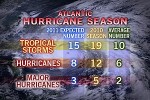
On the heels of an already devastating tornado season and a stormy spring, forecasters with the National Oceanic and Atmospheric Association (NOAA) are calling for an above-average Atlantic hurricane season this year.
Across the entire Atlantic Basin for the six-month season, which begins June 1 and lasts until Nov. 30, NOAA is predicting 12 to 18 named storms (winds of 39 mph or higher), of which six to 10 could become hurricanes (winds of 74 mph or higher), and three to six could become major hurricanes (Category 3, 4 or 5; winds of 111 mph or higher). Each of these ranges has a 70 percent likelihood of occurring according to forecasters, indicating that activity will exceed the seasonal average of 11 named storms, six hurricanes and two major hurricanes.
21 storms, of which 12 became hurricanes and five reaching major status, formed last year in the Atlantic—the highest number of formed storms since the 2005 season, which included Hurricanes Katrina and Rita that devastated the Gulf Coast—but none truly battered the United States. That’s because, though storms were strong, the jet stream and low wind shear caused most of the storms to remain in the open ocean in the Atlantic basin, said Jane Lubchenco, Ph.D., under secretary of commerce for oceans and atmosphere and NOAA administrator.
“The United States was fortunate last year. Winds steered most of the season’s tropical storms and all hurricanes away from our coastlines,” Lubchenco said. “However we can’t count on luck to get us through this season. We need to be prepared, especially with this above-normal outlook.”
Three predominate climate factors are shaping NOAA’s forecast this year, including the continuing high tropical activity era. Since 1995, the tropical multi-decadal signal has brought ocean and atmospheric conditions conducive for development in sync, leading to more active Atlantic hurricane seasons. Subsequently, warm Atlantic Ocean water temperatures, which fuels tropical formation and where storms often develop and move across, are up to two degrees Fahrenheit (warmer-than-average). Also, La Niña—a cooling of the waters in the Pacific Ocean— though expected to dissipate later this month or in June, its impacts such as reduced wind shear are expected to continue into the hurricane season.
“In addition to multiple climate factors, seasonal climate models also indicate an above-normal season is likely, and even suggest we could see activity comparable to some of the active seasons since 1995,” said Gerry Bell, Ph.D., lead seasonal hurricane forecaster at NOAA’s Climate Prediction Center located in Asheville.
The first tropical system for 2011 will be named Arlene upon reaching tropical storm strength with sustained winds of at least 39 mph. But since NOAA cannot pinpoint when and where any tropical storms may form, they, in partnership with the Federal Emergency Management Agency (FEMA), are holding a National Hurricane Preparedness Week in the U.S. this week to inform citizens on how to be safe if a hurricane hits their area. North Carolina Gov. Bev Perdue also proclaimed May 22-28 as Hurricane Preparedness Week in the state.
Residents are urged to create family emergency plans and prepare supply kits that should include a flashlight, radio, nonperishable food and a gallon of water per person, per day, to last three to seven days. Residents also are encouraged to review and update homeowners’ insurance policies now to make sure they include coverage for accidental damage and natural disasters. They also should make sure they are insured for flood damage.
“The tornadoes that devastated the South and the large amount of flooding we’ve seen this spring should serve as a reminder that disasters can happen anytime and anywhere. As we move into this hurricane season it’s important to remember that FEMA is just part of an emergency management team that includes the entire federal family, state, local and tribal governments, the private sector and most importantly the public,” said FEMA Administrator Craig Fugate.
“Now is the time, if you haven’t already, to get your plan together for what you and your family would do if disaster strikes. Visit ready.gov to learn more. And if you’re a small business owner, visit www.ready.gov/business to ensure that your business is prepared for a disaster,” added Fugate.
Bell also reminded that tropical storms can affect any plateau, including the mountains. He mentioned Hurricanes Ivan and Francis, which slammed Western North Carolina in 2004, as examples.
“Hurricane impacts are not limited to the coastline; strong winds and flooding rainfall often pose a threat across inland areas along with the risk for tornadoes,” Bell said.






